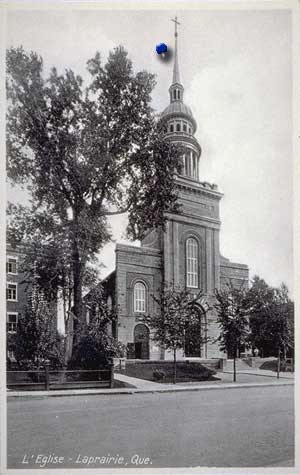For Whom the Bell Tolls.

The village church bells struck three times before tolling to invite parishioners to pray when Joseph died on 13 May 1847 at the age of 60. For three days the family kept watch over him in a shrouded room lit by candles in their home until he was buried from the church in LaPrairie. The record did not list a cause of death, but it should be noted that a horrific typhus epidemic was rampant that year. Just across the St-Lawrence River at Gross-Île fever sheds were built to house the Irish immigrants who fled the potato famine only to die from disease they brought across the Atlantic. Tens of thousands perished in Québec, Montréal and New York City. Had Joseph died from typhus however, it is likely he would have been buried immediately.
The family was in LaPrairie in 1847 as Joseph's burial record indicated he was de cette paroisse. Following the strictures of the Coutume de Paris (a civil code which had been imposed under the French regime by Louis XIV hundreds of years before), Charlotte would don black attire, dress, coat, hat and veil, as part of grand deuil. The requisite period for the death of a husband was at least a year and a day after his death, though up to a third year, or demi deuil, may be added during which she could wear black and white clothes.
An inventory of their property might be taken by a notary. More generous than the rights granted to women under English Common Law, she would be entitled to half of the property accrued during the marriage, in addition to any she owned previously. She did have the ability to oversee the settlement of any debts to the family. The woman's dower right came with a prohibition against remarriage before the mourning period had expired. Men were not saddled with similar restrictions.
Charlotte apparently never remarried and soon moved to Montréal with her children. Daughter Salomé married Olivier Lecompte there on August 11, 1851. She and her husband were living in a two-story frame home in the city with her mother, her widowed sister Marcelline, Marcelline's ten-year-old daughter Elmire Riel, and their four unmarried siblings: Pierre a forgeron, (was it Paul or Regis?) a carter, and sisters Martine and Denise. The city directory further explains that Lecompte was a carter who lived on Saint-Emery off of Saint-Denis. Charlotte's oldest son Joseph and his wife Florence Drolet still lived in LaPrairie where he was a farmer. Our ancestor Narcisse also stayed behind.
- http://www.everyculture.com/multi/Du-Ha/French-Canadian-Americans.html#ixzz3qedw47b3 (5 Nov 2015)
- image Canadian Archives
- La-Nativité-de-la-Bienheureuse-Vierge-Marie-de-Laprairie, page 180
- Typhus: https://www.canadianencyclopedia.ca/index.cfm?PgNm=TCE&Params=A1ARTA0002629 (13 June 2009)
- Mourning: https://www.freewebs.com/thecivilwarlady/mourningcustomsandrituals.htm
- The French-Canadian Heritage in New England, The Roots of Franco–American Culture, page 37-39 by Gerard J. Brault
- Widows Negotiate the Law: The First Year of Widowhood in Early- Nineteenth- Century Montreal, Bettina Bradbury, chapter 6 of Negotiating Identities in the 19th and 20th Centuries
- Salome marriage: Notre-Dame-de-Montréal, page 144, record M 269
